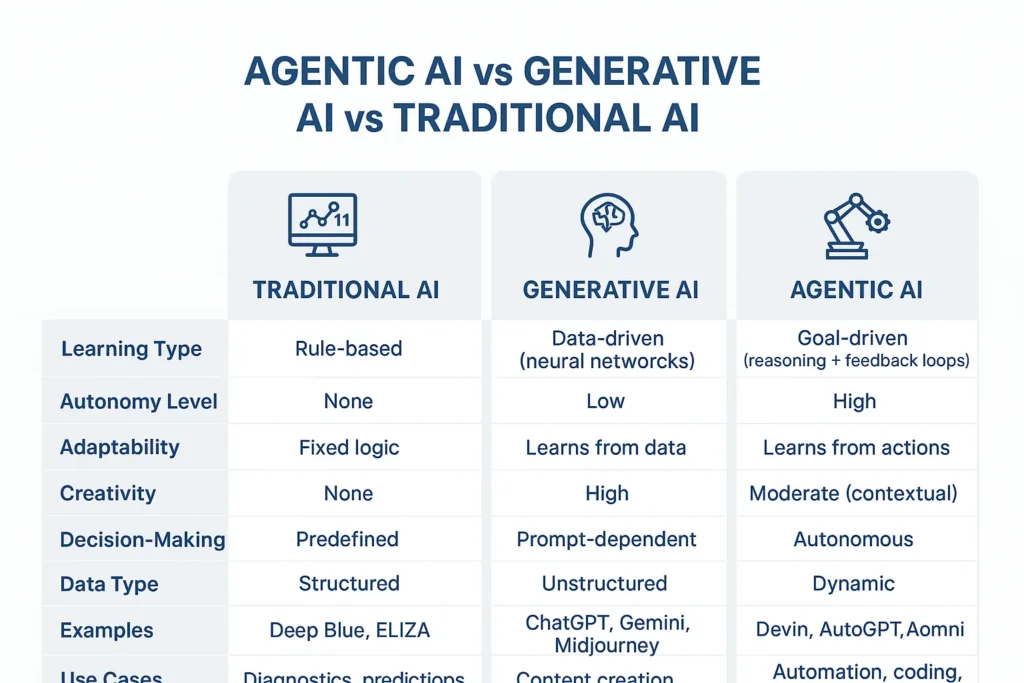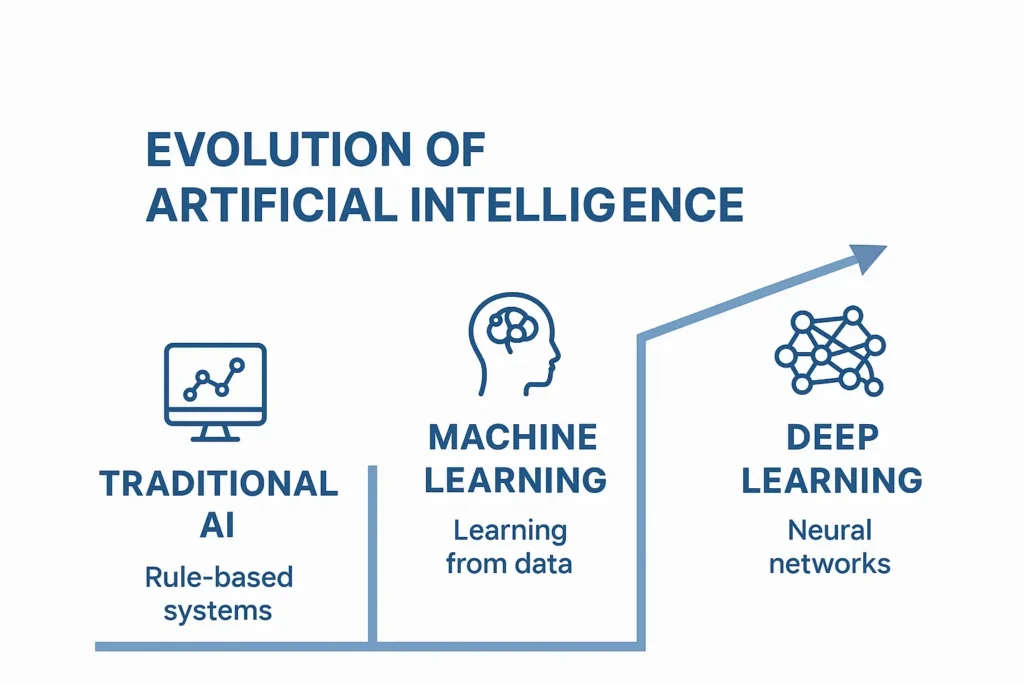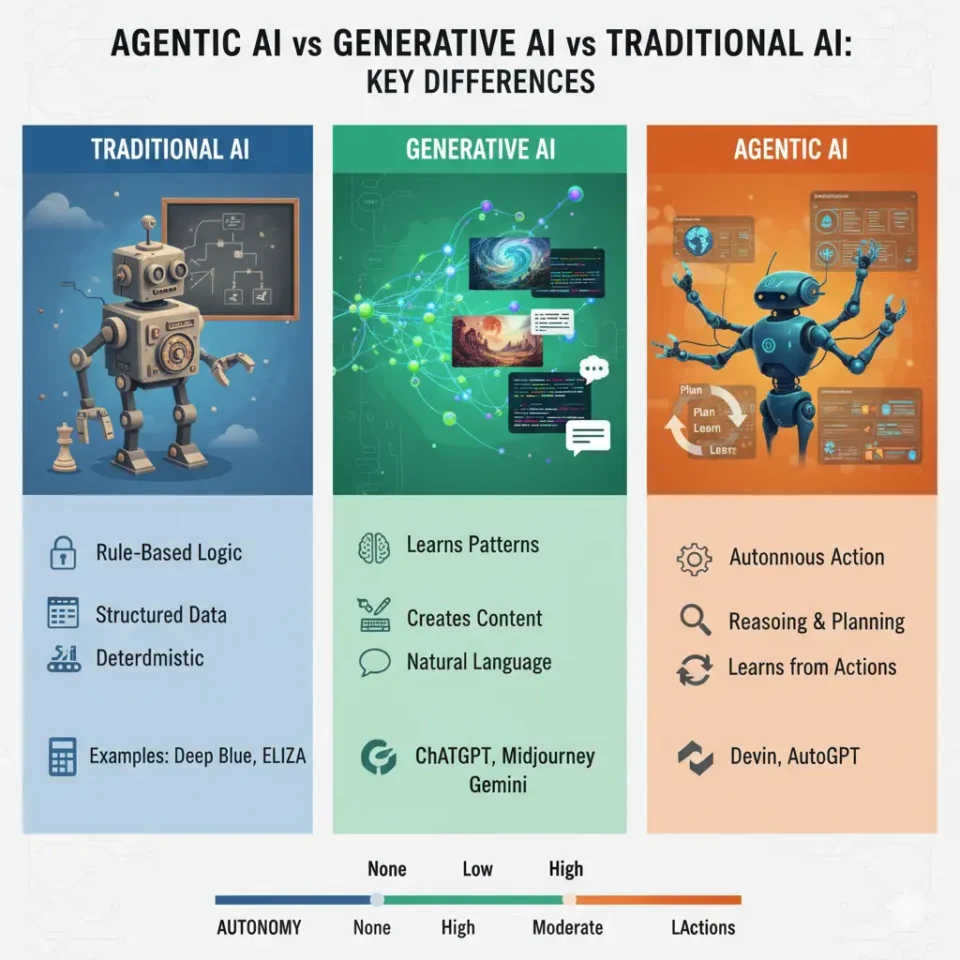Artificial Intelligence (AI) has evolved faster than any other technology in human history. From rule-based systems that could only follow instructions to autonomous agents that make decisions, AI has transformed how we think, work, and create.
This blog explain the core differences between traditional AI, generative AI and agentic AI, their applications, and their future impact on technology and business and how each shapes the way we interact with machines today.
What Is Traditional AI?
Traditional AI refers to the early generation of artificial intelligence systems designed to follow strict rules and logic. These systems were deterministic and they could only operate within the boundaries defined by human programmers.
Is Traditional AI still relevant? Absolutely, 78% of orgs use it for core analytics. It’s cheap, explainable, and scales for YMYL (Your Money, Your Life) compliance.
Key Characteristics:
- Rule-based decision-making
- Relies on structured, labeled data
- Operates within narrow domains
- Lacks creativity or self-learning capability
Example Tools:
- IBM Deep Blue – Defeated world chess champion Garry Kasparov in 1997
- ELIZA – The first chatbot (1966), simulated conversation through scripts
- Expert Systems – Used in medicine and finance for diagnostic reasoning
Strengths:
- Reliable in predictable, data-driven environments
- Easy to audit and explain
Limitations:
- No learning or adaptability
- Struggles with unstructured data or ambiguity
What Is Generative AI?
Generative AI (GenAI) marked a massive shift — from logic-based systems to learning-based models capable of generating new, original content. Instead of being told what to do, these models learn how to do it by analyzing vast datasets.
Key Characteristics:
- Learns patterns using deep neural networks
- Generates text, images, videos, and code
- Understands natural language and context
- Trained on large-scale, unstructured data
Example Tools:
- ChatGPT (OpenAI) – Conversational AI for writing, coding, and reasoning
- Google Gemini – Multimodal AI handling text, images, and video
- Midjourney / DALL·E 3 – AI for image and design generation
- Claude (Anthropic) – Safer, explainable text-based AI
Strengths:
- Creative and adaptive
- Scalable for automation and ideation
Limitations:
- Lacks autonomy — can’t act independently
- Requires human prompting and oversight
What Is Agentic AI?
Agentic AI represents the next frontier, AI systems capable of reasoning, decision-making, and taking autonomous actions in the real or digital world.
Unlike generative AI, which only produces outputs, agentic systems can plan tasks, execute them, and learn from outcomes, functioning as digital agents that perform continuous work loops.
According to Gartner, by 2026, nearly 40% of enterprise AI systems will include agentic functions such as autonomous task completion, tool use, and multi-step reasoning.
Key Characteristics:
- Operates autonomously with minimal human input
- Uses reasoning and planning loops (e.g., reflection, feedback)
- Integrates with APIs, tools, or environments to complete actions
- Continuously learns from success and failure
Example Tools:
- Devin (Cognition Labs) – The world’s first AI software engineer
- AutoGPT / BabyAGI – Self-directed AI agents for task automation
- OpenDevin / Aomni – Agentic platforms for coding and web automation
- ChatGPT o1 (Reasoning Model) – Early step toward reasoning-based AI
Strengths:
- Task automation with minimal human supervision
- Performs multi-step reasoning
- Adapts dynamically to new conditions
Limitations:
- High computational cost
- Ethical and safety concerns (autonomy risks)
Do you know: What is Ethical AI and Why is it Important?
Comparison Chart: Agentic AI vs Generative AI vs Traditional AI
| Feature | Traditional AI | Generative AI | Agentic AI |
| Learning Type | Rule-based | Data-driven (neural networks) | Goal-driven (reasoning + feedback loops) |
| Autonomy Level | None | Low | High |
| Adaptability | Fixed logic | Learns from data | Learns from actions |
| Creativity | None | High | Moderate (contextual) |
| Decision-Making | Predefined | Prompt-dependent | Autonomous |
| Data Type | Structured | Unstructured | Dynamic |
| Examples | Deep Blue, ELIZA | ChatGPT, Gemini, Midjourney | Devin, AutoGPT, Aomni |
| Use Cases | Diagnostics, predictions | Content creation, chatbots | Automation, coding, workflows |

Evolution Timeline of AI (1950s–2025)
| Era | AI Type | Key Milestones |
| 1950–1990s | Traditional AI | Rule-based systems, Expert systems, Chess programs |
| 2010–2020s | Generative AI | Deep learning, Transformers, GPT, Diffusion models |
| 2024–2025+ | Agentic AI | Reasoning models, Devin, Autonomous task agents |

The evolution shows a clear shift — from thinking within rules to thinking creatively and now to thinking independently.
Learn the complete guide on: AI vs Machine Learning vs Data Science
Business & Industry Impact
| Sector | Traditional AI | Generative AI | Agentic AI |
| Finance | Fraud detection | Report summarization | Automated investment bots |
| Healthcare | Diagnosis | Report drafting | Patient monitoring agents |
| Education | Adaptive testing | Essay grading | Personalized tutors |
| Marketing | Lead scoring | Ad copywriting | End-to-end campaign agents |
| Software Development | Debugging | Code generation | Full project execution (Devin) |
Agentic AI doesn’t just assist — it acts.
Businesses can use it to automate repetitive workflows, handle complex reasoning, or even develop software from scratch.
Future Outlook: The Agentic Era
As we enter the Agentic Era, the focus shifts from generation to execution. Agentic AI combines creativity (from GenAI) with autonomy (from traditional logic systems).
However, this leap also brings challenges:
- Ethical safety — ensuring AI agents act responsibly
- Data governance — maintaining transparency in decision-making
- Human oversight — keeping humans “in the loop”
Still, the opportunities are limitless. From software engineering to business automation, Agentic AI is redefining what “intelligent systems” mean.
Recommended AI Tools (by Category)
| Category | Recommended Tools | Description |
| Traditional AI | IBM Watson, MATLAB AI Toolbox | Data-driven modeling and predictions |
| Generative AI | ChatGPT, Gemini, Midjourney, Claude | Content creation, ideation, visual generation |
| Agentic AI | Devin, AutoGPT, Aomni, OpenDevin | Autonomous agents that plan and execute tasks |
Final Thoughts
The journey from Traditional AI to Generative AI and then Agentic AI reflects humanity’s quest to create systems that think, create, and act.
Generative AI unlocked creativity. Agentic AI adds purpose and action to that creativity.
As these systems mature, their combined potential will reshape industries, redefine productivity, and change how humans collaborate with machines.
FAQs
Many see it as revolutionary because it combines automation with reasoning, planning, and self-correction, going beyond simple scripted tasks. It aims to handle dynamic, multi-step goals, which is a significant leap.
Concerns often revolve around accountability if an agent makes a mistake, unintended consequences of autonomous actions, the potential for agents to develop “misaligned” goals, and the challenge of human oversight when agents operate independently.
The consensus is that it will likely automate many repetitive or even complex tasks, leading to a shift in human roles towards supervision, higher-level design, and problem-solving that requires uniquely human creativity and judgment. Some fear job displacement, while others see it as an enhancement tool.
With GenAI, you are constantly prompt-engineering for each step or iteration. With Agentic AI, you give it the high-level goal, and it handles the internal “prompting” (reasoning, planning) and execution steps itself, adjusting as needed, freeing the human from micro-management.
RAG: A method that augments LLMs with external information retrieval to enhance response accuracy.
Agentic RAG: Integrates RAG within an autonomous agent framework, enabling dynamic information retrieval and decision-making in real-time tasks.
RAG (Retrieval-Augmented Generation): Enhances LLMs by integrating external data retrieval, improving the accuracy and relevance of generated content.
Agentic AI: An advanced form of AI that combines reasoning, planning, and action-taking capabilities, allowing it to perform complex tasks autonomously.
AI Agent: An autonomous system that perceives its environment, reasons, and takes actions to achieve specific goals. It can interact with external tools, APIs, and databases.
LLM (Large Language Model): A machine learning model trained on vast text data to generate human-like text. It lacks inherent autonomy and requires external orchestration to perform tasks.


